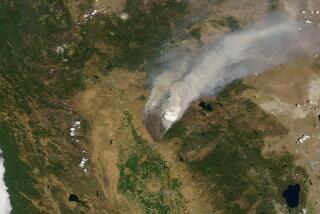Nature’s Course
Each new report indicates that the fire damage to Yellowstone National Park this summer wasnot as severe as first feared. Early estimates of as many as 1.5 million acres burned have been nearly halved. Only a small fraction of the park may have suffered severe damage.
Before the frost came, healthy green sprouts had poked through the charred ground. But the full story of the fires of 1988 will not be written for years. Not all the news to come will be good. For instance, a severe winter could result in the death of elk because of the destruction of their natural winter forage.
Reports of starving elk could trigger another round of controversy. Well-meaning people would call for a massive elk-feeding program. But that would be a mistake destined to make the animals dependant on human care in the future. Yellowstone has suffered an overpopulation of elk for decades, in part because of the disappearance half a century ago of the elk’s natural enemy, the wolf.
The fires’ greatest long-range benefit may be the scientific research showing the extent to which the natural order within the boundaries depends on human-directed events occurring outside the 2.2-million-acre park. Yellowstone is the core of a 13.5-million-acre area that has come to be known as the Greater Yellowstone Ecosystem, including Grand Teton National Park south of Yellowstone and seven adjoining national forests in three states. This is one of the country’s last regions in which the ecological processes operate much as they did before the onset of human influence.
The Greater Yellowstone Coalition has worked since 1983 to get federal officials to manage the parks and forests as a total unit. There has been political resistance from within the bureaucracy as well as from the outside.
Much of the surrounding forest land is wilderness, and its management is preservation-oriented, as in the parks. But in other areas the Forest Service has aggressively pursued a policy of leasing land for livestock grazing, logging and oil and gas exploration. The service recently outraged environmental groups and Teton County, Wyo., officials by approving an oil and gas project in a road-less portion of the Bridger-Teton National Forest. The access road will cut through an area designated by the U.S. Fish and Wildlife Service as a critical grizzly-bear habitat. Such actions can affect the balance of the entire region.
The first step is to pull together the facts needed to serve as the foundation for a total management program. An information exchange now is under way through a federal Yellowstone coordinating committee. It should be improved by bringing in other federal agencies and state and local governments. The fire experience should serve to accelerate this process and encourage Congress to consider the creation of a formal Yellowstone ecosystem management organization.
Yellowstone wildlife pay no heed to the park’s formal boundaries. Nor did this summer’s fires. It is time that federal management policies reflect the natural realities and wonders of the Greater Yellowstone Ecosystem.
More to Read
Sign up for Essential California
The most important California stories and recommendations in your inbox every morning.
You may occasionally receive promotional content from the Los Angeles Times.










